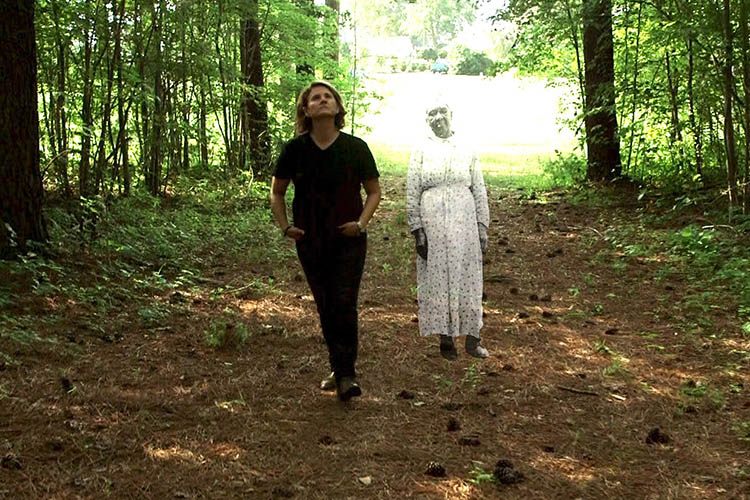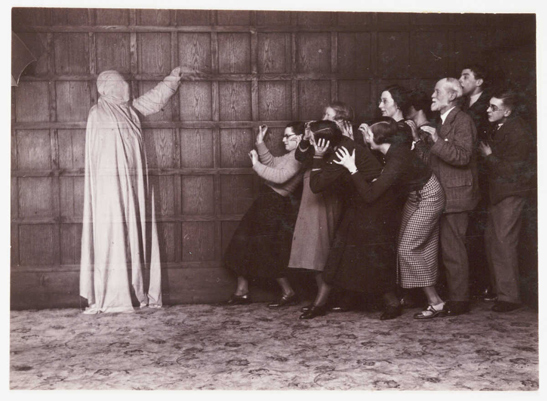I have a lot of experience with ghost stories. I’m a folklorist and professor at East Carolina University in Greenville, North Carolina, where I teach a popular class called The Supernatural.
My class, isn’t focused on proving or disproving experiences, rather we focus on what they mean and why they are told. For me, that means that some of my research on the supernatural deals with why we care so much about ghosts, spirits, cryptids, and all other manner of paranormal creatures.
In my classes we tend to see the opposite of most people’s experience in telling and researching ghost stories. There are no whispers in dark corners at parties, no campfires, no secrets over coffee or stronger drinks. We tell these stories under the bright florescent lights of a university classroom, where we discuss their importance and deconstruct what they mean. There’s something odd about discussing poltergeists at 8:00 am, something that makes these stories even more fragile and wrought with tension.
As we see frequently with paranormal stories in official spaces, at least for some cultures in North America, there’s a fear of derision, but we create a safe space and we tell them all the same. Trust me when I say the students want to share and hear stories – they are, pardon the pun, dying to tell me about their experiences. They’re not used to environments, especially academic ones, without judgement. Many of them come from backgrounds where the supernatural is either not believed or not allowed to be discussed. The students who haven’t experienced the paranormal are often a combination of jealous and terrified (and those who have an experience during the duration of the class or previous to it often report that they wished their supernatural experience never happened). We talk about strange noises, objects moving, footsteps, voices, and strange feelings, things that you’re not supposed to talk about, especially in a university classroom. But no matter how deep we get, or how close these stories make us feel to each other, we still have trouble discussing why all of these ghosts are so white and why the rare ghosts of color are stereotypes of stereotypes, tropes that would be unbelievable in a movie and openly shamed if we were talking about popular culture.

The ghosts here on campus, as they are in many other places, are not very diverse. This is surprising given our town’s population, which while still majority white (about 60%), has large Latinx, Indigenous, and Black communities. My classes do not always reflect this diversity and I’m often lucky to see 5-6 non-white faces in a class of 40.
On campus we have the story of a woman who hung herself after a bad breakup, a confederate soldier who haunts a Krispy Kreme, a theater ghost who wants to give just one more performance, and all of these ghosts are presumed white. Every single one of our Black ghosts were enslaved people, while our Indigenous ghosts are wholly absent with the exception of a place vaguely described as an “Ancient Indian Burial Ground” instead of any representation of an individual person.
I’ve heard stories of a mysterious presence in a local apartment that folds the clothes and tidies the rooms of white college women (presumed to be a formerly enslaved female, who “wants to help them”). When we discuss plantations, I hear stories about the ghosts of enslaved people still haunting locations where they were worked to death, who are now tortured in the afterlife by the ghost of the slaveowner or overseer.
So many of these stories highlight the centrality of white narratives, which is often painfully obvious in stories that white people tell about BIPOC. Many of their stories about enslaved people and “Indian princesses” say much more about their culture than it does about the non-white people in their stories. There is no acknowledgement of death as freedom for many enslaved Africans or the beliefs expressed in Indigenous narratives. Even the structure of these narratives has the clear mark of whiteness on it.

After giving a Nerd Nite talk at a local brewpub, a woman told me about the ghost of a man who was lynched. I was surprised to hear this story for the first time after almost a decade of living here. When I asked my students about it, they told me they did know a story about a local “hanging tree” (“lynching tree” I corrected them) where if you park underneath it and honk the horn, you’ll hear the feet of the man hung (lynched, I remind them again) brushing the top of the car. The students looked down, not wanting to make eye contact and refusing to engage until I move on to demonstrate the similarity between this ghost story and the legend of the Boyfriend’s Death. It was clear that those sorts of ghosts were not available for discussion. I press further, later on in the semester, but still nothing. Students who trust me with their most intimate stories, stories they’ve often never told anyone else, will not speak about race.
Even when I take students abroad to London to talk about ghosts there, the ghosts are white. London, one of the most multicultural cities in the world, is filled with white ghosts. The ghosts of queens and princes, ghosts with questionable names like “Scratching Fanny” and “The Screaming Spector,” theatre ghosts, but all white ghosts (at least, the ones who have, well had, bodies). The ghosts of London often match what the students think of London: all double-decker busses, royalty, and beefeaters. They frequently haven’t heard of the Windrush Generation or even the refugee camps at nearby Calais until we took them to a production of The Jungle, a play depicting life in a migrant camp, which left the students unable to speak.
Ghosts reflect how we see the dead and how we understand a place. On campus ghosts give us a sense of history and tales of warning. On study abroad they teach us about the people and history of a new place, and reinforce every single stereotype that we work so hard to deconstruct.
International travel is supposed to be eye-opening, but even the ghost tours cover up the worst of what’s happened, even while they’re telling stories of murder and death. Many see ghost stories as mere entertainment, as a tourist activity, something to give us a chill and send us on our way knowing that we’re safe….for now. However, we need to think more about those ghost stories and what they do and say about a place and the people who live there. When I’m in a generous mood, I think we purposefully leave ghosts of color alone because we don’t want them to haunt the places where they were so mistreated. We want them to have moved on to something better. When cynicism sets in, I think we leave ghosts of color alone because we don’t want to think about how they haunt us to this day. The specter of what happened to them is always present and we want to ignore it. But the old ignore-it-and-it-will-go-away tactic so often used with the supernatural doesn’t work here. We need to face these ghosts, who demand we acknowledge our true history, and spend more time exploring the ghosts that we don’t know about.
When given a space, my students also tell me stories of the ancestors who look over families and help out in times of need, the home altars with their offerings, the ceremonial wooden knives placed under beds to keep away nightmares and the dab tsog, the red strings tied around wrists and other amulets, and the stories of those who survived. They are the most important stories of all.
Dr. Andrea Kitta is a folklorist and professor at East Carolina University where she researches and teaches courses on pandemic illness, vaccination, modern medical folklore, urban legends, and the supernatural. She is the author of The Kiss of Death: Contagion, Contamination, and Folklore; Vaccination and Public Concern in History: Legend, Rumor, and Risk Perception; and co-editor of Diagnosing Folklore: Perspectives on Disability, Health, and Trauma. She is a two-time winner of the Brian McConnell Book Award from the International Society for Contemporary Legend Research and has won multiple awards for her teaching. She lives in Greenville, NC with her husband and way too many cats.


